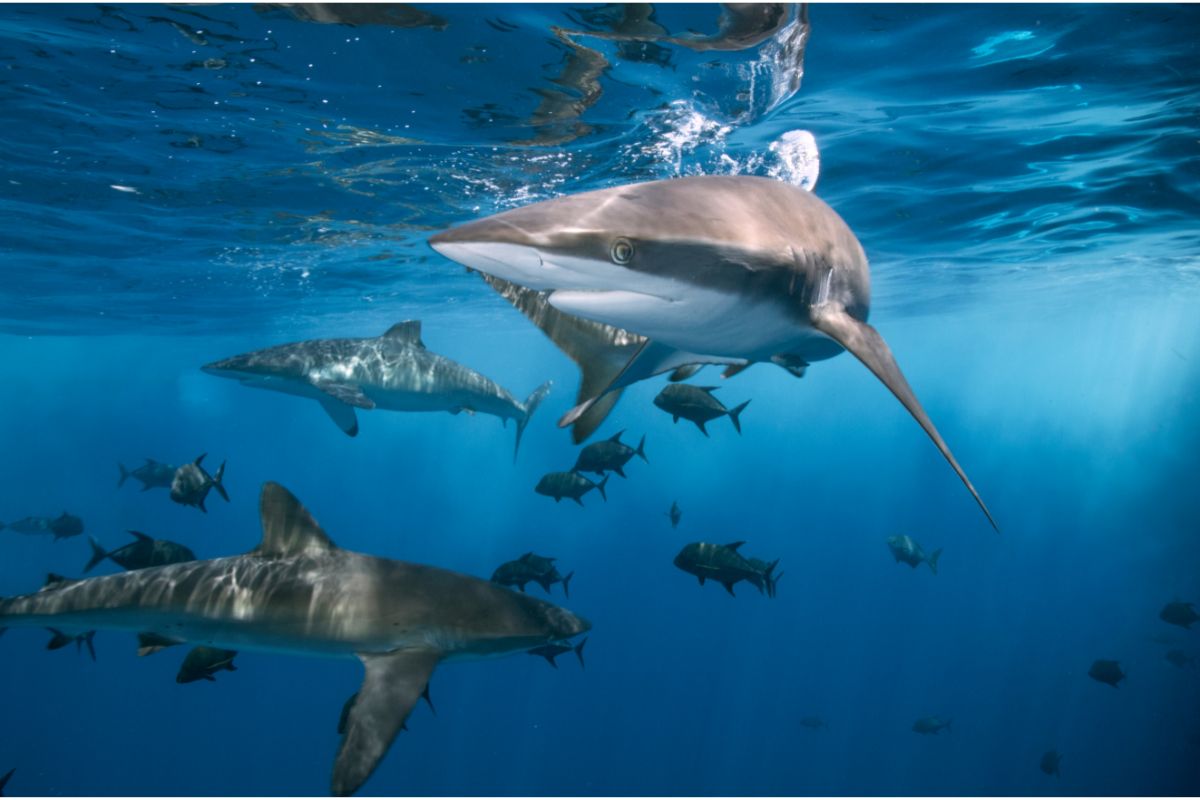Sharks are known for their sharp teeth and powerful jaws, as well as one other distinctive feature: those cold, black eyes that are capable of striking fear into the heart of the bravest swimmer.

There is a common assumption that sharks are blind, and this can provide some reassurance that their power ends with their muscular bodies and razor-sharp teeth.
In truth, however, many sharks have sophisticated, functional eyes that help to enhance their status as predators of the ocean.
We took a closer look at the eyesight of sharks and put together everything you need to know.
Are Sharks Blind?
The first thing we should note about shark vision is that it’s not like our own.
While humans have two eyes on either side of their head, sharks only have one eye on each side of their faces.
This means they must turn their heads from side to side in order to see around them, but it also offers greater peripheral vision, and can easily see a potential predator or source of prey approaching from the sides.
Sharks also don’t have eyelids, so when they close their eyes, there is no way to blink out any debris or dust particles that may be floating in front of their eyes.
Instead, they use an extra set of muscles called nictitating membranes (or “third eyelids”) to sweep away these small objects before they can enter the eye.
So what about their vision? It is true that there are some species of shark that are considered to be color-blind, and others that have significant visual impairments – but most do not suffer from total blindness.
In fact, sharks are able to detect light, even if its intensity is very dim. They can distinguish colors, and they can even perceive motion.
As we have mentioned, the location of the eyes on the sides of the head does offer great peripheral vision, but this can also put the shark at a disadvantage when it comes to object detection and depth perception; there are two natural blind spots, one just behind the head, and the other immediately in front of the nose.
Can Sharks See Colors?
As we have mentioned, there are a few species of shark that are completely colorblind, and it is true that most sharks cannot see and experience color in the same way as humans.
What they can do, however, is distinguish between dark and light colors.
This means that they can see a bright orange or yellow much more easily than a dark brown or navy blue, and so are more likely to be attracted to the former.
In addition, sharks are more likely to be attracted to anything that reflects the light at the top of the surface of the ocean – this tends to bear a strong resemblance to prey, and so is more likely to be attacked by a curious shark seeking to learn more.
High contrast colors are also more appealing, as they stand out against a dark background.
How Can Sharks Detect Motion?
While we might think that sharks would be unable to see movement, it turns out that they actually have excellent night vision.
Their eyes contain rods and cones, which allow them to see in low light conditions, and they can track moving objects over long distances.
They can also see movement through water and will move towards anything that moves through the water.
As such, sharks are often seen swimming upriver towards a fallen tree or log, where they wait for something to come along and get caught.
What About Sound?
According to experts, sharks have a sharp, acute sense of hearing, known as directional hearing.
This means that they are able to hear sounds coming from different directions, and can locate sources of sound with great accuracy.
This ability has been used by scientists to study how sharks navigate underwater, and to determine whether they can detect the presence of other animals, and the general consensus is that this excellent hearing forms a key role in the ability of sharks to track and hunt their prey successfully.
Other Methods of Detection

In addition to great hearing, there are two main specialized receptors that allow sharks to detect motion: the lateral line system, and the electroreceptor sensory cells.
- The Lateral Line System
The lateral line system consists of hundreds of tiny canals filled with fluid that are distributed across the skin of sharks, located just below the subcutaneous, and which are lined with tiny modified hair cells.
These pores act like an antenna, picking up vibrations in the surrounding water, and sending information back to the brain via nerves running down the spine.
As vibrations make contact with the cells, they sway and move in the liquid contained within, sending messages to the brain and providing information about the nature of the vibrations, and where they are.
The lateral line system helps sharks to keep track of things such as prey, predators, and obstacles and allows them to detect subtle changes in pressure.
- Electroreceptors
Sharks use electroreceptors to allow them to use gel-filled canals, which open at pores on the skin, to connect with the seawater outside their bodies.
These receptors are placed on the jaws, snout, and head, and compensate for the shark’s natural blind spot – this is a result of the placement of the eyes.
They allow the shark to locate prey just as it turns invisible in their eyeliner, and to attack at the opportune moment.
Final Thoughts
As humans, we often tend to place a heavy focus on the ability to see clearly all around us – this is, after all, our main method of communication and interaction with the world around us.
With sharks, however, the interaction with the world is less clear, and sharks have a wide range of methods to communicate with one another, and to detect and hunt down their prey – and they can do all this without relying solely on their eyesight, making them truly formidable predators and the rulers of the ocean.
- Is It Possible For A Shark To Swim Backwards? - August 2, 2022
- Are Leopard Sharks Dangerous? - August 2, 2022
- What Are The Differences Between Shark And Dolphin Fins? - August 1, 2022








